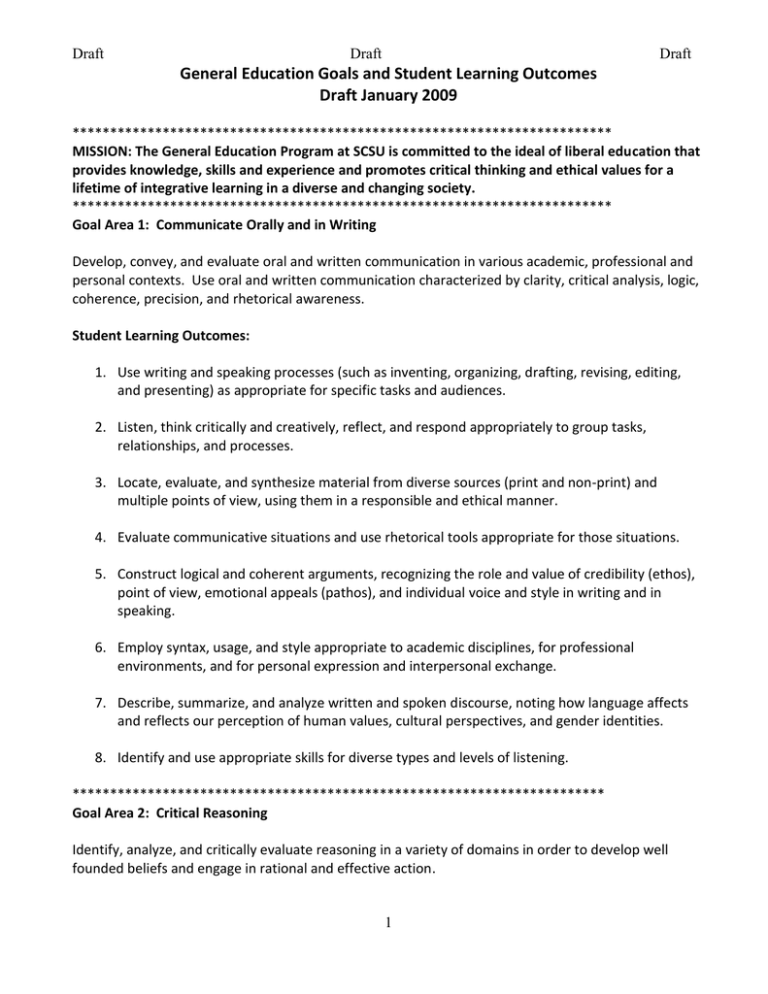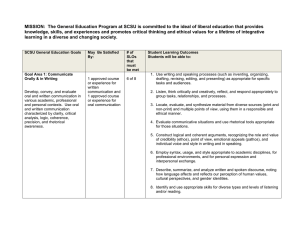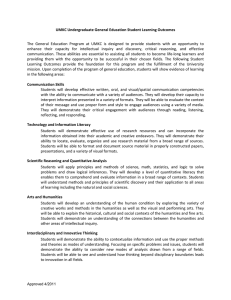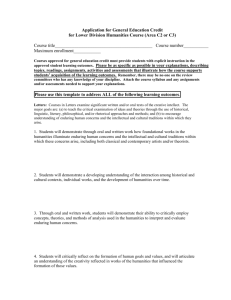General Education Goals and Student Learning Outcomes Draft January 2009
advertisement

Draft Draft Draft General Education Goals and Student Learning Outcomes Draft January 2009 ************************************************************************ MISSION: The General Education Program at SCSU is committed to the ideal of liberal education that provides knowledge, skills and experience and promotes critical thinking and ethical values for a lifetime of integrative learning in a diverse and changing society. ************************************************************************ Goal Area 1: Communicate Orally and in Writing Develop, convey, and evaluate oral and written communication in various academic, professional and personal contexts. Use oral and written communication characterized by clarity, critical analysis, logic, coherence, precision, and rhetorical awareness. Student Learning Outcomes: 1. Use writing and speaking processes (such as inventing, organizing, drafting, revising, editing, and presenting) as appropriate for specific tasks and audiences. 2. Listen, think critically and creatively, reflect, and respond appropriately to group tasks, relationships, and processes. 3. Locate, evaluate, and synthesize material from diverse sources (print and non-print) and multiple points of view, using them in a responsible and ethical manner. 4. Evaluate communicative situations and use rhetorical tools appropriate for those situations. 5. Construct logical and coherent arguments, recognizing the role and value of credibility (ethos), point of view, emotional appeals (pathos), and individual voice and style in writing and in speaking. 6. Employ syntax, usage, and style appropriate to academic disciplines, for professional environments, and for personal expression and interpersonal exchange. 7. Describe, summarize, and analyze written and spoken discourse, noting how language affects and reflects our perception of human values, cultural perspectives, and gender identities. 8. Identify and use appropriate skills for diverse types and levels of listening. *********************************************************************** Goal Area 2: Critical Reasoning Identify, analyze, and critically evaluate reasoning in a variety of domains in order to develop well founded beliefs and engage in rational and effective action. 1 Draft Student Learning Outcomes: Draft Draft 1. Distinguish between discourse that contains reasoning and that which does not. 2. Distinguish between different types of reasoning. 3. Analyze arguments, distinguishing premises and conclusions. 4. Evaluate inductive and deductive reasoning. 5. Apply basic logical techniques. 6. Identify and avoid fallacies. ************************************************************************ Goal Area 3: Natural and Physical Sciences Explore scientific knowledge of the natural world. Understand the central concepts and principles of science; experience the process of scientific inquiry; comprehend science as a human endeavor and understand the impact of science on individuals and on society. Student Learning Outcomes: 1. Demonstrate knowledge of concepts, principles, and theories in the physical or natural sciences. 2. Make observations and collect data, design and carry out experiments or other types of scientific investigations. 3. Formulate research questions and testable hypotheses, analyze and interpret data, draw inferences and conclusions, and identify further questions for investigation. 4. Demonstrate awareness of the interdependent relationships of basic science, applied science, mathematics, and technology. 5. Recognize the human nature of the scientific enterprise, including the importance of curiosity, creativity, and imagination; the dual nature of scientific knowledge as changeable and durable; and the impact of a scientist's personal identity on the scientific process. 6. Evaluate societal issues from a science perspective, question the evidence presented, and make informed judgments about these issues. ************************************************************************ Goal Area 4: Mathematical Thinking and Quantitative Reasoning 2 Draft Draft Draft Apply mathematics to analyze numerical relationships, solve problems, explain processes and interpret results. Student Learning Outcomes: 1. Demonstrate knowledge of the basic theories and methods of mathematics. 2. Use quantitative methods to test hypotheses and to construct quantitative solutions to problems. 3. Apply mathematical skills and knowledge in other academic disciplines. 4. Communicate quantitative ideas, both orally and in writing. *********************************************************************** Goal Area 5: History and the Social and Behavioral Sciences Develop understanding of human societies and behaviors, and of the concepts, theories, and methods of history and the social sciences. Student Learning Outcomes: 1. Describe or use the methods and data by which historians, social scientists, or behavioral scientists investigate human conditions. 2. Analyze human behavior, cultures, and social institutions and processes from the perspectives of history or the social and behavioral sciences. 3. Develop explanations for and explore solutions to historical or contemporary social problems. 4. Reflect upon themselves in relation to family, communities, society, culture, and/or their histories. 5. Apply and critique alternative explanatory systems or theories about human societies and behaviors. ************************************************************************ Goal Area 6: Humanities & Fine Arts Expand appreciation and critical understanding of changing modes of human expression and systems of thought in the arts and humanities, and develop abilities in the creation and performance of meaning. Student Learning Outcomes: 1. Demonstrate awareness of the scope and variety of works in the arts and humanities. 3 Draft Draft Draft 2. Describe and appreciate works in the arts and humanities as expressions of individual and collective values within an intellectual, cultural, historical and social context. 3. Interpret and respond critically to works from various cultures in the arts and humanities. 4. Explore intellectually the ideas expressed in works in the arts and humanities. 5. Engage in creative processes or interpretive performance. 6. Articulate an informed personal response to works in the arts and humanities. 7. Analyze the diverse means of communication in the arts and humanities. ********************************************************************** Goal Area 7: Racial and Ethnic Diversity in the U.S. Examine patterns of racial and ethnic inequality in the United States; the heritage, culture, and contributions of racially subordinated groups; and how race and ethnic relations are embedded in the institutions that structure our lives. Student Learning Outcomes: 1. Demonstrate awareness and understanding of historical and current race relations in the United States. 2. Explain the concept of “race.” 3. Analyze current events and conditions at the local, statewide, and national levels using course theories and concepts. 4. Identify forms of institutional discrimination in areas such as education, media, housing, employment, economics, politics, and the legal system. 5. Describe the basic history of discrimination against and contributions of African Americans, Asian Americans, American Indians, Latinos, and recent immigrants of color. 6. Engage in dialog and self-reflection concerning racism, racial oppression, and white privilege. ********************************************************************** Goal Area 8: Global Perspectives Develop a comparative perspective and understanding of one’s place in a global context. Student Learning Outcomes: 4 Draft Draft 1. Explain how they are connected and related to people elsewhere in the world. Draft 2. Describe similarities and differences among global places and populations. 3. Analyze how political, economic or cultural elements influence relations among the world’s states, peoples, or societies. 4. Analyze specific international issues and propose and evaluate responses. 5. Articulate a vision of their individual roles and responsibilities in a common global future. ************************************************************************ Goal Area 9: Ethical and Civic Engagement Understand and evaluate ethical or civic issues and theories, and participate in active citizenship or ethical judgment. Student Learning Outcomes: 1. Explain the connections among education, citizenship, and participation in a democratic society. 2. Explain major ethical or political theories. 3. Describe how interpretations of ethics or citizenship may vary by nationality, ethnicity, race, color, religion, gender, ability and disability, or sexual orientation. 4. Apply concepts such as democracy, rights, morality, justice, virtue, liberty and obligation to personal, professional, and public issues. 5. Analyze and evaluate alternative theoretical approaches or formulate solutions to ethical or civic issues. 6. Develop and exercise personal agency or ethical judgment in the public domain. ************************************************************************ Goal Area 10: Environmental Issues Examine the interrelationship of humans and the natural worlds from scientific and socio-cultural perspectives and the complex environmental challenges that result. Student Learning Outcomes: 1. Explain the basic structure and function of various ecosystems and human adaptive strategies within those systems. 5 Draft Draft 2. Discern patterns of interrelationships of bio-physical and socio-cultural systems. Draft 3. Describe the human institutional arrangements (social, legal, political, economic, and religious) that deal with environmental and natural resource challenges. 4. Analyze environmental and natural resource issues in light of understandings about interrelationships, ecosystems, and institutions. 5. Propose and assess alternative solutions to environmental problems including issues involving sustainability. ************************************************************************ Goal Area 11: Information Literacy & Technology To locate, evaluate critically, and use information to meet an identified information need and develop appropriate information technology skills. Student Learning Outcomes: 1. Identify and analyze an information need effectively and efficiently. 2. Access information using an effective search strategy and appropriate resources. 3. Critically evaluate information and its sources in order to determine information reliability and accuracy, and discern its point of view, bias, and authority. 4. Access and use information ethically and legally. 6


